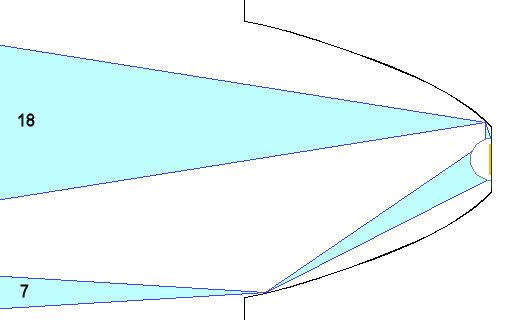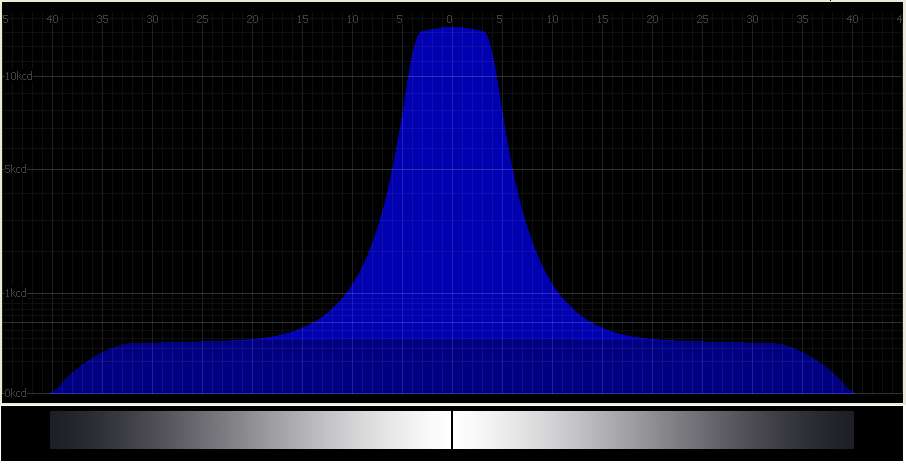I can’t remember right now which it is. It isn’t the large reflector light I now have a battery in.
That is interesting about the nearer center back part of the mirror casting a larger image of the LED. I need to think that over.
I had an illustrative idea to show. In the image below notice how deep the reflector is? It is a very, very shallow reflector. These lights throw a very tight beam a very long distance (originally built to find enemy aircraft in the sky at large distances).
So thusly a wide and shallow reflector throws the tightest beam and makes the case for the best thrower design in general. I believe the light source's location above the reflector makes no significant difference in this particular example. The light source is at the optimum focal point for a tight and long throw.
As a side note it seems that in a flashlight experiment placing the LED suspended above the parabolic reflector might be very interesting and lead to an extreme thrower if the reflector is shallow and wide.
The parabolic reflector/mirror is 60" (152.4 cm) in diameter and the searchlight has a peak output of 800,000,000 candlepower or candelas driven by a 15kW generator the light drawing 150 amps at 78 volts DC and has an effective beam visibility of 28 to 35 miles (45 to 56 km) in low humidity.

Even though the light at the edge of an LED is much smaller in area, because of the mirror’s proximity, it’s converging angles are much wider. Angle in = angle out.

I am sorry to be off topic but what if the LED emitters were made in a semi-spherical shape instead of planar?
That would be very useful indeed, and if that shape would be globular you would have a led shining in all directions which is great for household bulbs. But such a led is not there and that must have something to do with a more difficult or impossible production process, and perhaps also with the more difficult heatsinking of such a led.
So, who wants to join me in an experiment that costs roughly $33.00? ![]() I have found a new optic that produces a 1º beam angle with an XP-G2. Usable with XM-L2, SBT70, XHP70, whatever. All producing the absolute lowest angle of any collimation device seen to date.
I have found a new optic that produces a 1º beam angle with an XP-G2. Usable with XM-L2, SBT70, XHP70, whatever. All producing the absolute lowest angle of any collimation device seen to date.
Designed for throw, the XP-G2 is estimated to have a 16M hot spot at 800M. SBT70 31M at 1200M! But, this one is gonna take some creativity. It’s 157mm in diameter, 79mm depth. It has screw mount capability through it’s holder, uses a dual lens system with the large lens being of the Fresnel variety.
It’s new, and has a 20 piece MOQ. :~
I want to try this so bad! But not $660 worth of want…
Nice picture. When I was a kid, a lot of car dealers and some others had these as signs.
Since the source must be nearly isotropic, or at least a hemisphere, it seems that it would have had the same throw and wider beam with a shorter focal length mirror. So I think the very long focal length must be for practical reasons such as size and weight, cost or to be able to use a sphere as an approximation to a parabola.
Extreme thrower flashlights either are retro-reflectors, as you say, or else have lenses.
I hadn’t expected that until Dr. Jones mentioned it. That must be part of why lights with singe segment lenses form clear images of their LEDs and reflector lights don’t. With the lens convex in front, the focusing surface is about the same distance from the emitter everywhere, though that depends on the refractive index. Now it is not clear to me why reflector lights have spots with fairly sharp edges.
I wrote a program to simulate the beam pattern of a LED in a (SMO) paraboloid reflector, here's a screenshot for an S2+ (blue) and S2 (red) comparison.

It uses a ray tracing method and simulates about 50 million (depending on reflector size) rays to calculate the angular beam distribution.
You can see spot, corona and spill - just with a perfect parabola; for the deep S2 reflector the corona is nearly as wide as the spill.
And it shows an effect I didn't expect to be that strong: Deep reflectors reduce flux output (lumens) due to the higher fraction of reflected light and the reflexion losses (I calculated with a reflectivity of 85%).
The throw actually increases and the spot gets smaller with larger depth, that is to say shorter focal length. The opposite of what one would expect from first order and what actually happens with lenses. Also the spot and spill nearly merge into each other.
Am I understanding what you calculated?
Why doesn’t the limit of the luminance times the aperture make them both throw the same? Is that from the more efficient reflection at lower angles?
It's due to the bigger 'dead hole' for shallow reflectors, i.e. the bigger diameter of the part of the parabola that would be behind the LED and is of course omitted. The longer the focal length, the bigger the dead hole.
We have a lot of road construction in our area and the skies are virtually always filled with dust. I find it very interesting to shine a light up into the night sky with all this dust present, it clearly shows the spill, corona and hot spot area as it penetrates into the night.
I have 80 lights. 10 MT-G2, various assorted XM-L2 and XP-L and a few XP-G2, including de-domed and throwers. Shining these up into the night sky, the visible beam pattern is very interesting to see and I don’t believe any of my lights produce light in a pattern consistent with what the above graph/chart shows. Sorry, but in the real world I just haven’t seen that effect. Deep narrow reflectors put light out in a narrow cone, with the center “V” being more sharply defined as the hot spot. Lights like the Solarforce Skyline I, MaxToch SN6X-2X, and others that aren’t as deep but have close to a 1:1 ratio. Lights like the big Solarforce S2200 MT-G2 make a huge cone of a beam profile, as do the short/comparitively wide K3 and the floody triples.
Have you tried the S2? It's quite special in that respect.
There is no best ratio. Take any given size reflector and add a little more length to it and it’ll have more throw. Add a little more and more throw will be gained. As long as you add length without changing what you originally started with, it can only get better. The longer it gets, the less you stand to gain but you will keep gaining. Obviously, there’s a point where it becomes an impractical size for a flashlight and the gains aren’t worth it.
Also the longer it gets, the higher the manufacturing precision needs to be.
I think the quote below was intending that one end change and the other end stay fixed.
“As long as you add length without changing what you originally started with,” Which brings up the point about how to judge the “best place” for the emitter in relation to the rear of the reflector.
How do we know if we have the emitter focused correctly? Do we just cut off the reflector 1/2 an emitter height longer then the optimal focal point? (assuming we are using domed emitters)
Should they make concave or convex emitters?
Getting crazy:
how about liquied cooled spherical emitters?
Is there a better shape then flat?
For throw? Actually any shape is fine for a parabola. Just make sure the (virtual image of the) LED is in it's focus. Theoretically it suffices that any part of the LED sits in the point of focus. Or even more general, that every ray from reflector surface through the focal point hits the die, which even allows for some shift up and down.
However there's some manufacturing inaccuracy...
The bigger the reflector (height and/or depth) and the smaller the LED, the higher the required precision.
A spherical emitter would allow using the parts of the parabola behind the LED, but such an emitter with the same flux (lumen) and size (diameter) would actually throw less (same flux divided by higher surface gives less luminance), and have heat sinking problems.
A concave hemisphere might be interesting, could do some photon recycling. But might only be better compared to a flat LED of same surface (not diameter).
Here's the beam profile of a 25mm diameter, 17mm deep reflector, this time the simulation distinguishes between contributions by direct light not hitting the reflector (shown in a darker color), which forms the spill, and light hitting the reflector, forming spot and corona (shown brighter).
Note the nonlinear scale, the direct light contribution to the spot is actually about 2%!

To fully comprehend the chart, I’m supposed to think on the plane at the bottom such that the overall width shows the dimmer portion of the cone of light and the rising tapered portion indicates brighter areas towards the center with the hot spot being the very top of the chart. Is this right?
I was trying to see that as the cone of light before and of course light doesn’t bend so I was confused. ![]()
So perhaps something like this?

Yes, sort of. The spill cone has 40° half width, so it's 80° wide. The spot is about 8° wide.
I think I'll add the option to simulate a beamshot when I find the time for it.